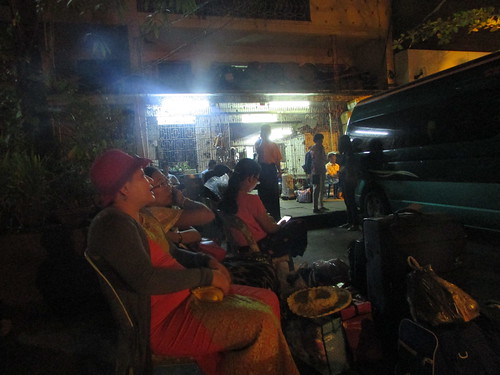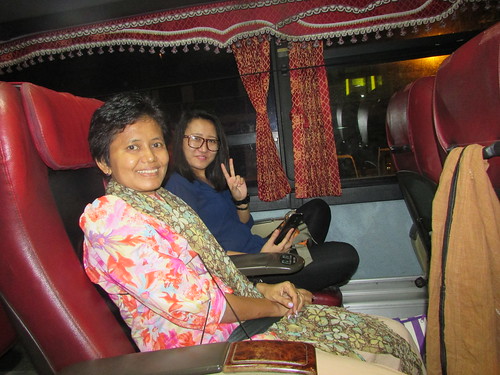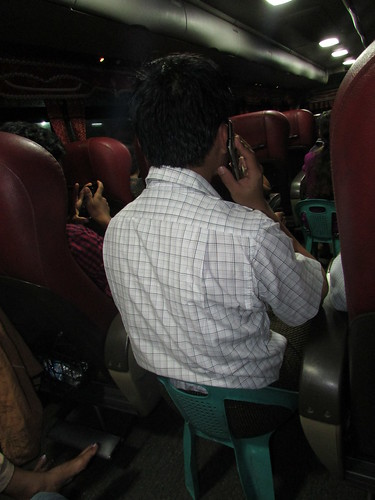Background
This was my fourth visit to Mon State and my third visit looking at OVC initiatives. The first, purely sightseeing, visit was part of my trip to Myanmar in 2012. You can find all in posts on this trip here. Then, in 2014, I accompanied Doctor HlaTun on his annual tour of inspection of projects which he part supports. My posts on this trip are here. I returned with the Doctor in 2015, as described in my posts here.
Travelling to Mon State
>On Sunday 17th April 2016, Doctor Hla Tun, Myint, Mi Mi and the writer left Yangon after 9.30 p.m. on one of the many 'Overnight Coaches' widely used to travel around the country.
 Waiting for the bus outside the travel office in Yangon.
Waiting for the bus outside the travel office in Yangon.
The reclining seats on the bus were in rows of 2 on left of gangway, 1 on right, pre-allocated. I discovered that, in almost every case, the latch on the seat back was defective so that seats were permanently reclined.
 Myint and Mi Mi before we leave Yangon.
Myint and Mi Mi before we leave Yangon.
I had been puzzled by the tiny plastic moulded chairs carried on the bus. Once people were seated in the reclining seats, additional passengers were accommodated in the gangway on the small chairs.

Seating 2 + 1 + plastic seat in gangway.
Events of Monday, 18th April 2016
On arrival at Mawlamyine Bus Terminal, we were met by a car and driver which took us to the 'CARE' charity administrative offices where it had been arranged we could wash and briefly relax before setting off again by car to travel further south. I'm afraid it was 'brief' as it was around 5.00 a.m. when we arrived and the Doctor wanted to set off at about 6.00 a.m.!
Once on the road, the Doctor made a stop at a typical tea house for a snack with the sweet, milky tea the Burmese (and I) enjoy. Then, we stopped at the Win Sein Taw Ya Pagoda, housing the World's Largest Reclining Buddha. It was my fourth visit, but I believe the first for Myint and Mi Mi. Shortly after my third visit a year ago, the elderly monk responsible for the project passed away and there is now a hall of remembrance in his honour. Further building work was also apparent on both the original and second reclining Buddha figures.
By about 8.00 a.m. we had reached Kot Kha Pon - the first of the Drop In Centres ('DIC') we were to visit. Quite a few of the children who attend the centre were unable to be present on that date so distribution of school-related gifts was fairly quickly completed, the balance being left with the staff.
Our next visit was to Ka Mar Wet DIC, Where, as usual, we were made very welcome. After the presentations, the traditional group photographs were taken outside the DIC, with the children wearing their new, just received, uniforms.
To reach Ko Dut, where we would spend the night, our route took us through Thanbyuzayat on the main road. This was the location where the Death Railway, built by prisoners of the Japanese in 1942-1943, joined the Burmese main railway line south from Mawlamyine. For some time, one of the Japanese steam locomotives which was used on the Death Railway has been 'plinthed' at this location but what I'd not seen before was a modern museum building labelled 'THE DEATH RAILWAY MUSEUM' which opened earlier in 2016 and was packed with visitors. The Doctor purchased admission tickets (the 'Foreigner' pays an enhanced rate) and we looked around. The centre piece of the ground floor was a large 'trompe d'oeil' painting extending across the floor which attempted (fairly successfully) to give the impression of standing on a wooden trestle trestle bridge on the line. I was disappointed that lots of visitors were taking the opportunity to take that elusive "This is me standing on the Death Railway" picture. The other display material was, I thought, rather thin but appeared better researched. I left the museum with mixed feelings. I believe we must confront the evil in our past but I wasn't convinced that a 'Disneyworld' approach was appropriate. Afterwards, I found I piece from the 'Daily Telegraph' at here which appeared to share my reaction.
We stopped to visit the large pagoda on our route to Ko Dut and also looked at the Mon Ethnic School, where further building work was in hand. The new building replaced the now-abandoned wooden temporary shelter, now suffering termite attack. More startling, immediately behind the temporary shelter, a tall, shining triangular-section cellular radio transmission tower has appeared, complete with equipment cabinets and a large, sloping framework to support solar panels.
We were invited for an evening meal at the home of the manager of Ko Dut DIC. By this time, I was very tired so, on arrival at the DIC itself (where Myint, Mi Mi and I were to sleep on the naturally-ventilated upper floor) I was just keen to set up the thin sleeping mats and the mosquito nets and collapse.
Related posts
Next post describing this trip.
All my posts on this trip can be found here.
My pictures
Travelling to and from Mon State.
Win Sein Taw Ya Pagoda.
there are other pictures at Burma-2016. More pictures will be posted as soon as possible.
[Additional material added 21-Apr-2016: Link to pictures added 7-May-2016: Pictures and notes added 29-May-2016]

